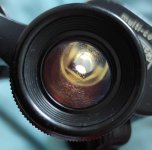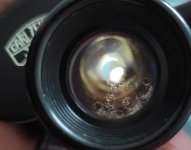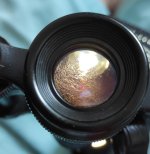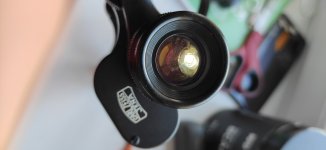Hello, can some please tell me what kind of dirt is it (fungus?) and can i clean it somehow? How bad is it could it damage the lens if view is sharp and clean?
-
Welcome to BirdForum, the internet's largest birding community with thousands of members from all over the world. The forums are dedicated to wild birds, birding, binoculars and equipment and all that goes with it.
Please register for an account to take part in the discussions in the forum, post your pictures in the gallery and more.
You are using an out of date browser. It may not display this or other websites correctly.
You should upgrade or use an alternative browser.
You should upgrade or use an alternative browser.
Zeiss binocular dirt (1 Viewer)
- Thread starter Pawel582
- Start date
More options
Who Replied?Owlbarred
Well-known member

Sadly, it's internal fungal growth, likely the result of being kept in high humidity conditions during storage. IIRC, Zeiss won't accept for repair any binoculars with internal fungal growth, but there are apparently a few private repair shops that will.
Re: doing the work yourself, I have no knowledge of the pitfalls/possibilities.
Re: doing the work yourself, I have no knowledge of the pitfalls/possibilities.
Last edited:
Hi Pawel and welcome.
If it is external it could be very rough cleaning.
If internal it looks like rather unusual fungus.
It could be cleaned, but would leave marks, and a replacement binocular of the same type in good condition would be cheaper.
Either way, it isn't good news.
There will be a loss of contrast, although some viewing may be possible.
It could be a repairer in Poland charges little, as I know there are a lot of competent optical people there.
It looks like a Zeiss Jena, maybe 7x50 or 10x50?
Regards,
B.
If it is external it could be very rough cleaning.
If internal it looks like rather unusual fungus.
It could be cleaned, but would leave marks, and a replacement binocular of the same type in good condition would be cheaper.
Either way, it isn't good news.
There will be a loss of contrast, although some viewing may be possible.
It could be a repairer in Poland charges little, as I know there are a lot of competent optical people there.
It looks like a Zeiss Jena, maybe 7x50 or 10x50?
Regards,
B.
Last edited:
Owlbarred
Well-known member

Ruins the image big time. The fungus is likely, by now, also on the prisms, confounding the problem. Someone with more knowledge needs to reply on whether they merit repair.affects the image somehow? worth cleaning?
We have to establish whether it is external eyepiece very rough cleaning or more likely internal fungus.
In the U.K. a replacement binocular is cheaper.
If there is a lot of internal fungus it depends how bad and how much a local repairer charges.
It is likely to be uneconomic to repair, unless someone does it himself, and also knows how to align binoculars.
Regards,
B.
In the U.K. a replacement binocular is cheaper.
If there is a lot of internal fungus it depends how bad and how much a local repairer charges.
It is likely to be uneconomic to repair, unless someone does it himself, and also knows how to align binoculars.
Regards,
B.
Carl zeiss 8x30w jenoptem mutlicoated they dont have any scratched only fungusIf, in fact, the binocular is rare then fungus is better than very badly scratched eyepieces.
What binocular is it?
Regards,
B.
Thank you, Pawel.
The binocular is not worth repairing, as it is likely the fungus is also on the internal metal surfaces.
If it has a case, throw the case away, and unfortunately, either keep the binocular well away from any cameras or other optics, throw it away, or give it to someone who routinely cleans fungus.
In Hong Kong, stripping camera lenses and cleaning fungus was so routine that there were many capable people, but now I don't know whether this is so common.
Taylor Hobson lenses were designed for easy stripping down, but most optics don't have this feature.
I have seen worse fungus but your binocular is pretty bad.
Regards,
B.
The binocular is not worth repairing, as it is likely the fungus is also on the internal metal surfaces.
If it has a case, throw the case away, and unfortunately, either keep the binocular well away from any cameras or other optics, throw it away, or give it to someone who routinely cleans fungus.
In Hong Kong, stripping camera lenses and cleaning fungus was so routine that there were many capable people, but now I don't know whether this is so common.
Taylor Hobson lenses were designed for easy stripping down, but most optics don't have this feature.
I have seen worse fungus but your binocular is pretty bad.
Regards,
B.
Last edited:
But view looks clear and sharp i have a chance to get it full cleaned for 25$ (man who deal with old binocular) don't know if it's worth it this model of binoculars is carl zeiss 8x30w mutlicoated cleaning may somehow make it worse now?Thank you, Pawel.
The binocular is not worth repairing, as it is likely the fungus is also on the internal metal surfaces.
If it has a case, throw the case away, and unfortunately, either keep the binocular well away from any cameras or other optics, throw it away, or give it to someone who routinely cleans fungus.
In Hong Kong, stripping camera lenses and cleaning fungus was so routine that there were many capable people, but now I don't know whether this is so common.
Taylor Hobson lenses were designed for easy stripping down, but most optics don't have this feature.
I have seen worse fungus but your binocular is pretty bad.
Regards,
B.
PeterPS
Well-Known Member

For about 50-60$ you can buy a pair in a much better condition, for example:Carl zeiss 8x30w jenoptem mutlicoated they dont have any scratched only fungus
Fernglas Carl Zeiss Jena Jenoptem 8x30 W multi-coated
But they have double viewFor about 50-60$ you can buy a pair in a much better condition, for example:
Fernglas Carl Zeiss Jena Jenoptem 8x30 W multi-coated
Yes, in Poland price for cleaning old binocular is not high, and why not store in leather case can i somehow sterilize it?For $25? I'd do it, especially if I already owned it. I've owned that model before - it's not fantastic (especially by modern standards) but still useful, especially if you don't wear glasses. Once cleaned, don't store them in the original leather case.
Last edited:
Hi Pawel,
The case is a write off, just throw it away. It will have fungal spores even if cleaned.
Use any new case, even from something quite different.
You may have something suitable at home.
For $25, yes let the man do his best.
The internal black paint and lens edge paint will also have fungus, so the repair man probably knows how to deal with this.
I presume the repair man knows how to collimate a binocular.
Leica fakes often come from Poland quite openly. They are quite skilled with optics, even shady ones.
There will probably be track marks even when cleaned, but the view would be good.
The coating will be marked, but this shouldn't be bad.
As you say, an uncollimated binocular is no good.
Even when cleaned I would keep the binocular away from good optics as there may be residual fungal spores.
Your binocular may have been stored in an open garage or similar.
In WW2 British binoculars were completely full of fungus in six weeks from new in the jungle.
Special repair facilities were set up and binoculars frequently cleaned.
Store optics in a maximum relative humidity of 60%, preferably 40%.
Minimum 13C to about 25C.
Don't store in cases. Leave in the open in a dry place.
Don't store in drawers.
The choice is yours.
Let the repair man do his best or buy a very good well collimated replacement.
Regards,
B.
The case is a write off, just throw it away. It will have fungal spores even if cleaned.
Use any new case, even from something quite different.
You may have something suitable at home.
For $25, yes let the man do his best.
The internal black paint and lens edge paint will also have fungus, so the repair man probably knows how to deal with this.
I presume the repair man knows how to collimate a binocular.
Leica fakes often come from Poland quite openly. They are quite skilled with optics, even shady ones.
There will probably be track marks even when cleaned, but the view would be good.
The coating will be marked, but this shouldn't be bad.
As you say, an uncollimated binocular is no good.
Even when cleaned I would keep the binocular away from good optics as there may be residual fungal spores.
Your binocular may have been stored in an open garage or similar.
In WW2 British binoculars were completely full of fungus in six weeks from new in the jungle.
Special repair facilities were set up and binoculars frequently cleaned.
Store optics in a maximum relative humidity of 60%, preferably 40%.
Minimum 13C to about 25C.
Don't store in cases. Leave in the open in a dry place.
Don't store in drawers.
The choice is yours.
Let the repair man do his best or buy a very good well collimated replacement.
Regards,
B.
HiHi Pawel,
The case is a write off, just throw it away. It will have fungal spores even if cleaned.
Use any new case, even from something quite different.
You may have something suitable at home.
For $25, yes let the man do his best.
The internal black paint and lens edge paint will also have fungus, so the repair man probably knows how to deal with this.
I presume the repair man knows how to collimate a binocular.
Leica fakes often come from Poland quite openly. They are quite skilled with optics, even shady ones.
There will probably be track marks even when cleaned, but the view would be good.
The coating will be marked, but this shouldn't be bad.
As you say, an uncollimated binocular is no good.
Even when cleaned I would keep the binocular away from good optics as there may be residual fungal spores.
Your binocular may have been stored in an open garage or similar.
In WW2 British binoculars were completely full of fungus in six weeks from new in the jungle.
Special repair facilities were set up and binoculars frequently cleaned.
Store optics in a maximum relative humidity of 60%, preferably 40%.
Minimum 13C to about 25C.
Don't store in cases. Leave in the open in a dry place.
Don't store in drawers.
The choice is yours.
Let the repair man do his best or buy a very good well collimated replacement.
Regards,
B.
I have one more question can i somehow check condition of the anti-reflection coating?
The condition of the anti reflection coating cannot be known until the surfaces are cleaned.
Fungus can sometimes just be wiped off without it eating the coating.
Sometimes it can eat the coating but not the glass or it can eat both.
Fungus can leave track marks in the coating, or the coating and glass.
As to the glass, some old simple glass types are very resistant to fungus.
I have 1800s lenses that are completely clean.
I have seen some multi element more modern lenses completely destroyed by fungus on most if not all surfaces.
Leaving optics in outside garages, or by the sea, or in attics is not a good idea, at least in England.
In some very dry places, fungus may be rare or not seen at all.
Unfortunately, I have seen numerous lenses, binoculars and telescopes full of fungus.
Also leaving sofas and excellent wooden or veneered tables in an outside garage is a sure way of destroying them.
Better take them straight to the tip.
Regards,
B.
Fungus can sometimes just be wiped off without it eating the coating.
Sometimes it can eat the coating but not the glass or it can eat both.
Fungus can leave track marks in the coating, or the coating and glass.
As to the glass, some old simple glass types are very resistant to fungus.
I have 1800s lenses that are completely clean.
I have seen some multi element more modern lenses completely destroyed by fungus on most if not all surfaces.
Leaving optics in outside garages, or by the sea, or in attics is not a good idea, at least in England.
In some very dry places, fungus may be rare or not seen at all.
Unfortunately, I have seen numerous lenses, binoculars and telescopes full of fungus.
Also leaving sofas and excellent wooden or veneered tables in an outside garage is a sure way of destroying them.
Better take them straight to the tip.
Regards,
B.
Similar threads
- Replies
- 15
- Views
- 1K
Users who are viewing this thread
Total: 2 (members: 0, guests: 2)










